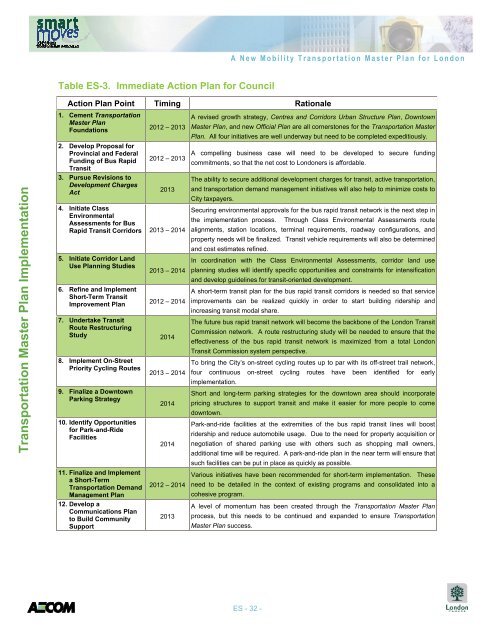A New Mobility Transportation Master Plan for London
A New Mobility Transportation Master Plan for London
A New Mobility Transportation Master Plan for London
Create successful ePaper yourself
Turn your PDF publications into a flip-book with our unique Google optimized e-Paper software.
<strong>Transportation</strong> <strong>Master</strong> <strong>Plan</strong> Implementation<br />
Table ES-3. Immediate Action <strong>Plan</strong> <strong>for</strong> Council<br />
Action <strong>Plan</strong> Point Timing Rationale<br />
1. Cement <strong>Transportation</strong><br />
<strong>Master</strong> <strong>Plan</strong><br />
Foundations<br />
2. Develop Proposal <strong>for</strong><br />
Provincial and Federal<br />
Funding of Bus Rapid<br />
Transit<br />
3. Pursue Revisions to<br />
Development Charges<br />
Act<br />
2012 – 2013<br />
2012 – 2013<br />
2013<br />
4. Initiate Class<br />
Environmental<br />
Assessments <strong>for</strong> Bus<br />
Rapid Transit Corridors 2013 – 2014<br />
5. Initiate Corridor Land<br />
Use <strong>Plan</strong>ning Studies<br />
6. Refine and Implement<br />
Short-Term Transit<br />
Improvement <strong>Plan</strong><br />
2013 – 2014<br />
2012 – 2014<br />
7. Undertake Transit<br />
Route Restructuring<br />
Study 2014<br />
8. Implement On-Street<br />
Priority Cycling Routes 2013 – 2014<br />
9. Finalize a Downtown<br />
Parking Strategy<br />
10. Identify Opportunities<br />
<strong>for</strong> Park-and-Ride<br />
Facilities<br />
11. Finalize and Implement<br />
a Short-Term<br />
<strong>Transportation</strong> Demand<br />
Management <strong>Plan</strong><br />
12. Develop a<br />
Communications <strong>Plan</strong><br />
to Build Community<br />
Support<br />
2014<br />
2014<br />
2012 – 2014<br />
2013<br />
A <strong>New</strong> <strong>Mobility</strong> <strong>Transportation</strong> <strong>Master</strong> <strong>Plan</strong> <strong>for</strong> <strong>London</strong><br />
A revised growth strategy, Centres and Corridors Urban Structure <strong>Plan</strong>, Downtown<br />
<strong>Master</strong> <strong>Plan</strong>, and new Official <strong>Plan</strong> are all cornerstones <strong>for</strong> the <strong>Transportation</strong> <strong>Master</strong><br />
<strong>Plan</strong>. All four initiatives are well underway but need to be completed expeditiously.<br />
A compelling business case will need to be developed to secure funding<br />
commitments, so that the net cost to <strong>London</strong>ers is af<strong>for</strong>dable.<br />
The ability to secure additional development charges <strong>for</strong> transit, active transportation,<br />
and transportation demand management initiatives will also help to minimize costs to<br />
City taxpayers.<br />
Securing environmental approvals <strong>for</strong> the bus rapid transit network is the next step in<br />
the implementation process. Through Class Environmental Assessments route<br />
alignments, station locations, terminal requirements, roadway configurations, and<br />
property needs will be finalized. Transit vehicle requirements will also be determined<br />
and cost estimates refined.<br />
In coordination with the Class Environmental Assessments, corridor land use<br />
planning studies will identify specific opportunities and constraints <strong>for</strong> intensification<br />
and develop guidelines <strong>for</strong> transit-oriented development.<br />
A short-term transit plan <strong>for</strong> the bus rapid transit corridors is needed so that service<br />
improvements can be realized quickly in order to start building ridership and<br />
increasing transit modal share.<br />
The future bus rapid transit network will become the backbone of the <strong>London</strong> Transit<br />
Commission network. A route restructuring study will be needed to ensure that the<br />
effectiveness of the bus rapid transit network is maximized from a total <strong>London</strong><br />
Transit Commission system perspective.<br />
To bring the City’s on-street cycling routes up to par with its off-street trail network,<br />
four continuous on-street cycling routes have been identified <strong>for</strong> early<br />
implementation.<br />
Short and long-term parking strategies <strong>for</strong> the downtown area should incorporate<br />
pricing structures to support transit and make it easier <strong>for</strong> more people to come<br />
downtown.<br />
Park-and-ride facilities at the extremities of the bus rapid transit lines will boost<br />
ridership and reduce automobile usage. Due to the need <strong>for</strong> property acquisition or<br />
negotiation of shared parking use with others such as shopping mall owners,<br />
additional time will be required. A park-and-ride plan in the near term will ensure that<br />
such facilities can be put in place as quickly as possible.<br />
Various initiatives have been recommended <strong>for</strong> short-term implementation. These<br />
need to be detailed in the context of existing programs and consolidated into a<br />
cohesive program.<br />
A level of momentum has been created through the <strong>Transportation</strong> <strong>Master</strong> <strong>Plan</strong><br />
process, but this needs to be continued and expanded to ensure <strong>Transportation</strong><br />
<strong>Master</strong> <strong>Plan</strong> success.<br />
ES - 32 -


